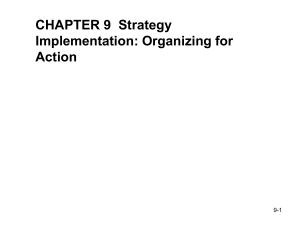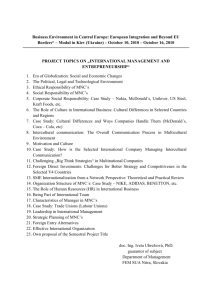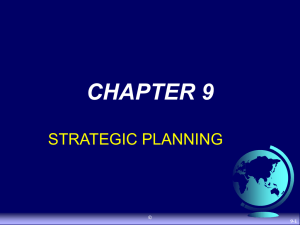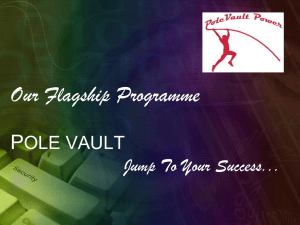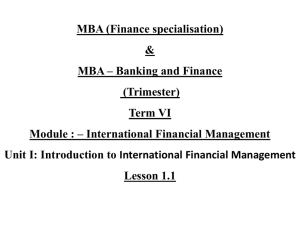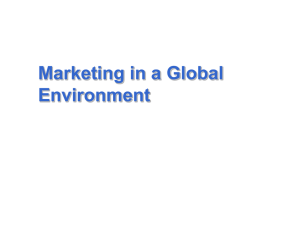• The Rise of the Multinational Typical Risks: Currency Corporation (MNC)
advertisement
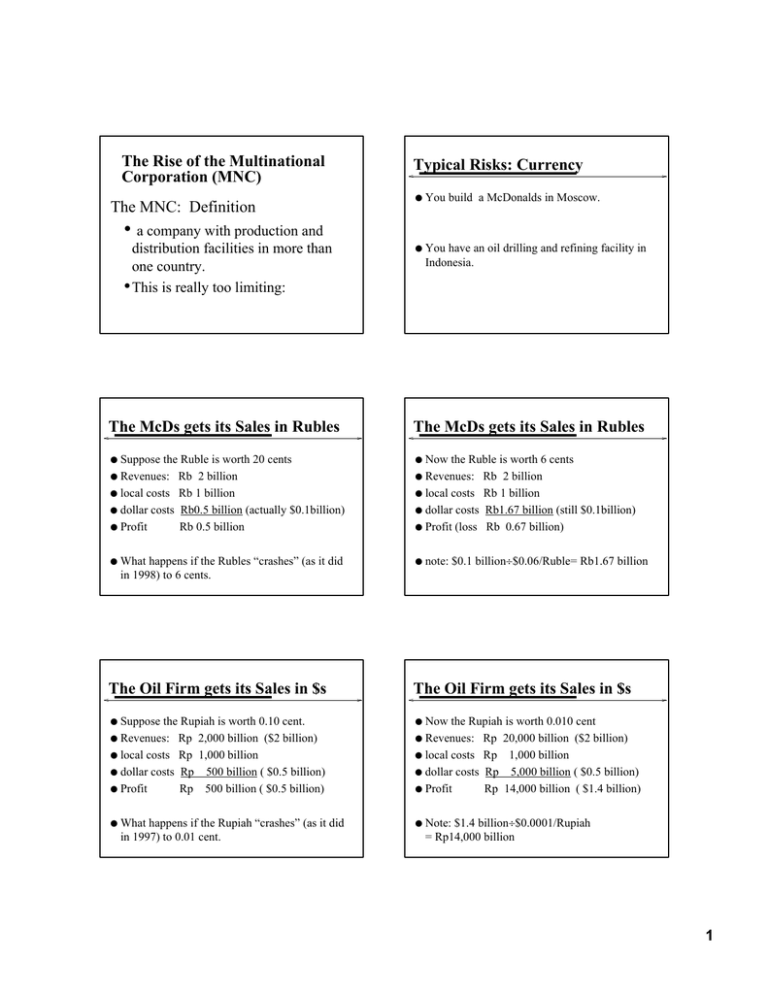
The Rise of the Multinational Corporation (MNC) The MNC: Definition Typical Risks: Currency l You build a McDonalds in Moscow. l You have an oil drilling and refining facility in Indonesia. • a company with production and distribution facilities in more than one country. • This is really too limiting: The McDs gets its Sales in Rubles The McDs gets its Sales in Rubles Suppose the Ruble is worth 20 cents Revenues: Rb 2 billion l local costs Rb 1 billion l dollar costs Rb0.5 billion (actually $0.1billion) l Profit Rb 0.5 billion Now the Ruble is worth 6 cents Revenues: Rb 2 billion l local costs Rb 1 billion l dollar costs Rb1.67 billion (still $0.1billion) l Profit (loss Rb 0.67 billion) l l l What happens if the Rubles “crashes” (as it did in 1998) to 6 cents. l l l note: $0.1 billion÷$0.06/Ruble= Rb1.67 billion The Oil Firm gets its Sales in $s The Oil Firm gets its Sales in $s Suppose the Rupiah is worth 0.10 cent. Revenues: Rp 2,000 billion ($2 billion) l local costs Rp 1,000 billion l dollar costs Rp 500 billion ( $0.5 billion) l Profit Rp 500 billion ( $0.5 billion) Now the Rupiah is worth 0.010 cent Revenues: Rp 20,000 billion ($2 billion) l local costs Rp 1,000 billion l dollar costs Rp 5,000 billion ( $0.5 billion) l Profit Rp 14,000 billion ( $1.4 billion) l l l What happens if the Rupiah “crashes” (as it did in 1997) to 0.01 cent. l l l Note: $1.4 billion÷$0.0001/Rupiah = Rp14,000 billion 1 Consider a Utah Ski Lodge Political Risk: l American Customers This is a domestic company but has currency risk l What if the dollar rises to 3 CHF ? l l l Civil Disturbances, wars. Corrupt local (host) governments. l Changes in tax rates l Changes in pollution laws. l Rise in litigation. (Phillip Morris?) The Rise of the MNC The Rise of the MNC EVOLUTION OF THE MNC • l Reasons to Go Global: 1. raw materials 2. New markets 3. minimize costs of production The Rise of the MNC l MARKET SEEKERS • produce and sell in foreign markets • heavy foreign-direct investors • Most common today: IBM Coca Cola Nestle McDonald’s RAW MATERIAL SEEKERS • exploit markets in other countries • historically first to appear • modern-day counterparts Anaconda Copper Exxon Royal Dutch/Shell The Rise of the MNC l COST MINIMIZERS • seek lower-cost production abroad • motive: to remain cost competitive • representative firms: Texas Instruments Nike (Doonesberry cartoon)_ Zenith 2 MNCs and Political Risk l Which type of MNC is most likely to be a target for nationalization or bad treatment by the host government? Which type has the lowest political risk? l the low cost seeker Answer: raw material seeker The MNC is often taking “irreplaceable” resources such as oil, copper etc. l Usually easy for the local country to keep an existing mine, well etc. running (developing the mine, etc. is the hard part). l Output is usually a commodity that is easily sold on the world market. l The low cost seeker ... Provides “low wage” jobs to locals but the wages tend to be excellent by local standards. The last thing employees want is for the local government to be messing with their paychecks! l Also, this type of MNC mostly ships in parts for assembly, and ships out the finished product to its own global distribution network. l What about political risk for the Market seeker? Market Seekers tend to ... compete with local producers. l Example: Coca Cola in India competed with local beverage manufactures. Government “required” CC to give them access to the “secret formula” as a condition of being allowed to sell in India. l Was this requirement a food safety issue? l Coca Cola left rather than comply. l Recent Belgium event. l l About in the middle 3 The Rise of the MNC II. THE PROCESS OF OVERSEAS EXPANSION The Rise of the MNC l A. Exporting: • preferred market entry strategy l 1. Advantages: l low cost l low risk l learning opportunity l Overseas Production: the Last Step 1. Advantages: a. Nearer to customer, shorter supply lines, delivery times. b. shows commitment to the market, assures customer that parts and comprehensive service will always be there. Licensing Disadvantages of licensing: a. Lower cash flow, profits l b. Quality standards of licensee (partner) may be lower than yours and can harm your brand reputation l c. Eventually you may create a new competitor due to sharing of technology and other trade secrets. l l THE RISE OF THE MULTINATIONAL CORPORATION 2. Disadvantages inability to realize full sales potential 3. Can gradually add one’s own a. Distribution system b. Sales subsidiaries c. Service subsidiaries Licensing Local firm produces your product and pays you a royalty. 1. Advantages: a. Your firm ties up only a minimal investment b. Faster market entry, using established distribution system of your “partner”. c. With less time and capital tied up, you essentially have less risk (currency exposure, political risk, etc) Direct Foreign Investment: by U.S. MNCs in other Countries 1. Mostly in developed countries: implies dominance of market seekers, and not low-cost seekers. 2. Mostly in manufacturing and other services (not petroleum) suggesting that raw material seekers do not dominate. 4 The Cumulative Sum of Foreign Investment by U.S. and non U.S. Investors (incl. MNCs) Investment by Foreign MNCs in the U.S. 1. The United Kingdom is number one. Common language - similar corporate culture to U.S. 2. Japan is number two: auto plants dominate. Classic market seekers. See table showing their many auto plants in the U.S. U.S. investment overseas grows each year, but in the last two decades, foreign investment in the U.S. has grown faster. The graph at the end of appendix B shows all classes of investments: (1) direct (majority ownership), (2) portfolio (stocks and bonds), and (3) short-term deposits. Cumulative Net Foreign Investment Examples : net Foreign Investment However, these figures are based on historical cost, and thus, understate the U.S. current value foreign investment. For example, land bought in Europe in the 1950s is worth much more today. Foreign investment in the U.S. is more recent, and reflects higher costs of construction, land, stocks, etc. l U.S. a creditor: 1956 GM spends $20 million on an Opal plant in Germany. 1980, Fidelity purchases $1 billion worth of foreign stock. l U.S. a debtor. 1985 Toyota spends $2 billion on a new plant in Kentucky. 1985 British Petroleum takeover Standard Oil of Ohio. Bank of Japan sells Yen to buy U.S. Treasury Bill l Only recently has net income from investments shifted away from the U.S. Net Foreign Investment The net income from these investments (dividends and interest) is much closer than the net wealth deficit would suggest. l However, the U.S. has now become (starting only a few years ago), a net payer of interest and dividends. l Based on these historical figures the U.S. has been, since the middle of the 1980s, the world’s largest debtor. l Japan is the world’s largest creditor. l 5
